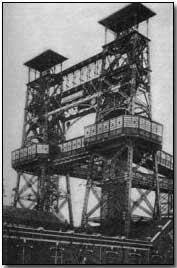Battles - The Battle of Loos, 1915
 The Battle of Loos formed a part of the wider Artois-Loos Offensive conducted by
the French and British in autumn 1915, sometimes referred to as the Second
Battle of Artois.
The Battle of Loos formed a part of the wider Artois-Loos Offensive conducted by
the French and British in autumn 1915, sometimes referred to as the Second
Battle of Artois.
The Artois campaigns comprised the major Allied offensive on the Western Front in 1915.
Along with the attack against Loos by the British, French troops launched offensives at Champagne (the Second Battle of Champagne), and at Vimy Ridge in Arras. The French and British High Command, notably French Commander-in-Chief Joseph Joffre, relied upon numerical supremacy - 3 to 1 in favour of the French at Champagne - to overpower the Germans.
The Loos offensive began on 25 September following a four day artillery bombardment in which 250,000 shells were fired, and was called off in failure on 28 September. Presided over by Douglas Haig, the British committed six divisions to the attack. Haig was persuaded to launch the Loos offensive despite serious misgivings.
He was much concerned at both a marked shortage in available shells (sparking the shell shortage scandal in Britain in 1915), and at the fatigued state of his troops; he was further concerned at the nature of the difficult terrain that would need to be crossed. All considered, he favoured a delay before the offensive at Loos was put underway, while these concerns were addressed.
Set against these concerns however was the reality that the British enjoyed massive numerical supremacy against their German opposition at Loos, in places of 7 to 1. Once the preliminary artillery bombardment had concluded, Haig's battle plans called for the release of 5,100 cylinders of chlorine gas (140 tons) from the British front line. The quantity of gas used was designed to entirely overcome the primitive state of German gas mask design in use at the time.
Unfortunately the release of gas was not without mixed results. In places the wind blew the gas back into the British trenches, resulting in 2,632 British gas casualties, although only seven actually died.
Haig's strategy involved the deployment of I and IV Corps in the gap between Loos and the La Bassee Canal, while II and III Corps formed diversionary attacks. Once the first German position fell reserves from IX Corps, aided by cavalry, would pass through the gap and attack the German second line.
 The southern section of Haig's attack, conducted by IV Corps, made
significant progress on the first day of the battle, somewhat to Haig's
surprise, capturing Loos and moving onwards towards Lens. However,
supply problems, and a need for reserves brought the advance to a halt at
the end of the first day.
The southern section of Haig's attack, conducted by IV Corps, made
significant progress on the first day of the battle, somewhat to Haig's
surprise, capturing Loos and moving onwards towards Lens. However,
supply problems, and a need for reserves brought the advance to a halt at
the end of the first day.
Haig had asked the British Commander-in-Chief, Sir John French, to make available IX Corps for potential reserve use the same day, but French had argued that they would not be required until the following morning. The troops were eventually released during the early afternoon but delays whilst travelling meant they only arrived at night, IX Corps consisting of two 'New Army' divisions (21st and 24th), fit but untested in battle.
Meanwhile, north of the Hulloch-Vermelles road, which ran across the battlefield, I Corps made less progress, with the British gas attack far less effective than in the Loos Valley. Even so, 7th and 9th Divisions managed to establish a foothold on the Hohenzollern Redoubt.
The delay in making available the reserves was however crucial. The Germans, whose lines of defences at Hulloch and Hill 70 were in any case formidable, poured in reserves to counter-attack the following day. Indeed, the German defences on the second day were stronger than those available at the start of the battle: except that by day two, 26 September, the British no longer had the benefit of a preliminary artillery bombardment.
Advancing towards the Germans that afternoon without covering fire, they were decimated by repeated machine gun fire, the Germans astonished that the attack had been launched without adequate cover.
After several days of sporadic fighting the British were eventually forced to order a retreat. It was during this battle Rudyard Kipling's son, John, was lost believed killed; the fact that he was listed as missing sparked a crusade by his parents to locate his body and give it a proper burial, without success.
The Loos attack was renewed by the British on 13 October, when further heavy losses combined with poor weather caused the offensive to be called off.
During the battle the British suffered 50,000 casualties. German casualties were estimated much lower, at approximately half the British total. The British failure at Loos contributed to Haig's replacement of French as Commander-in-Chief at the close of 1915.
Elsewhere at Champagne and Vimy Ridge, French progress was initially good, but solid defence by the German Third, Fifth and Sixth Armies (under General Einem, Crown Prince Wilhelm and Prince Rupprecht) prevented the French front achieving any long-term gains.
Photograph courtesy of Photos of the Great War website
A 'whizzbang' was a high-velocity, low-trajectory shell that made a shrill approach noise and then a sharp explosive report.
- Did you know?
